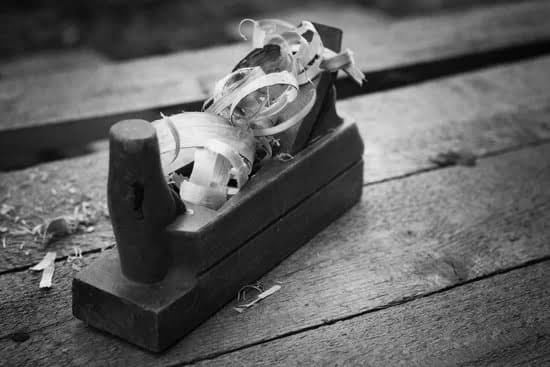Are you interested in learning how to make a scarf joint woodworking? The scarf joint is a crucial technique in woodworking that allows two pieces of wood to be joined end-to-end to create a longer piece, all while preserving the strength and integrity of the original wood.
This article will provide an in-depth guide on everything you need to know about making a scarf joint, from understanding its purpose and benefits, choosing the right wood, selecting the necessary tools and equipment, to providing a step-by-step guide, tips and tricks, common mistakes to avoid, and creative ways to use scarf joints in woodworking projects.
The scarf joint is an essential skill for any woodworker looking to create longer wooden pieces without sacrificing strength or stability. Whether you are a beginner looking to expand your woodworking skills or an experienced craftsman seeking to perfect your joinery techniques, mastering the art of creating scarf joints will undoubtedly elevate your craftsmanship.
This article aims to guide you through the process and provide you with the knowledge and expertise needed to confidently incorporate this technique into your woodworking projects.
In this comprehensive guide, we will cover everything from the basics of scarf joint woodworking to advanced techniques for achieving flawless results. From understanding the purpose and benefits of using scarf joints, choosing the right wood for your projects, selecting the necessary tools and equipment, all the way through practical tips for achieving perfect results – this article has got you covered. So let’s dive in and explore the world of scarf joint woodworking together.
Understanding the Purpose and Benefits of Scarf Joints
Scarf joints are an essential part of woodworking, especially when it comes to creating strong and seamless connections between pieces of wood. Understanding the purpose and benefits of scarf joints is crucial for any woodworker looking to master this technique.
Purpose of Scarf Joints
The main purpose of a scarf joint is to create a long, continuous piece of wood by joining shorter pieces together. This type of joint is commonly used in situations where a single, long piece of wood is not available or practical to use. By carefully cutting and fitting two pieces of wood together at an angle, a strong and durable connection can be achieved.
Benefits of Scarf Joints
One of the key benefits of scarf joints is the strength they provide. When properly executed, scarf joints create a connection that is as strong as the original piece of wood. This makes them particularly useful for structural applications where strength and durability are essential. Additionally, scarf joints allow for flexibility in woodworking projects by enabling the use of smaller or reclaimed pieces of wood that may have otherwise gone to waste.
Importance in Woodworking
For woodworking projects that require long, uninterrupted pieces of wood, such as boat mast or furniture legs, scarf joints are indispensable. They enable woodworkers to create the necessary length without compromising on strength or stability.
Furthermore, mastering the art of creating perfect scarf joints opens up a world of creative possibilities in woodworking, allowing for more efficient use of materials and unique design elements in projects. Whether you’re building furniture, restoring historical structures, or constructing marine vessels, understanding how to make a scarf joint in woodworking is a valuable skill worth honing.
Choosing the Right Wood for Scarf Joints
When choosing the right wood for scarf joints in woodworking, it is important to consider the strength and grain pattern of the wood. One of the most commonly used types of wood for scarf joints is hardwood, such as oak, maple, or cherry. These types of wood are known for their durability and ability to withstand the pressure and stress that comes with joining two pieces together using a scarf joint.
Additionally, it is essential to select wood with straight and even grain patterns to ensure a seamless and strong joint. This helps to prevent any weak spots in the joint that could cause it to fail over time. It is also important to choose wood that is free from knots, as these can affect the integrity of the joint.
Furthermore, when considering the right wood for scarf joints, it is crucial to think about how the finished piece will be used. For example, if you are creating a structural element such as a beam or a support piece, you will want to use a dense and sturdy type of wood like teak or mahogany.
However, if you are making decorative items or furniture pieces, you may opt for lighter woods like pine or cedar. Understanding how different types of wood will perform in various applications is essential when selecting the right one for your scarf joint woodworking project.
In summary, choosing the right wood for scarf joints in woodworking involves considering factors such as strength, grain pattern, and intended use. By carefully selecting the appropriate type of wood for your project, you can ensure that your scarf joints are both visually appealing and structurally sound. Understanding these considerations will help you achieve successful and long-lasting results in your woodworking endeavors.
Tools and Equipment Needed for Making Scarf Joints
When it comes to making scarf joints in woodworking, having the right tools and equipment is essential for achieving a seamless and strong joint. Whether you are working on a small DIY project or a larger woodworking endeavor, here are the key tools and equipment you will need to create impeccable scarf joints.
Measuring and Marking Tools
Before cutting into your wood, you will need measuring tools such as a tape measure, ruler, or combination square to accurately measure and mark the length of your scarf joint. Additionally, marking tools like a pencil or marking knife will be necessary for outlining the cut lines on the wood.
Cutting Tools
The primary tool needed for creating scarf joints is a saw. A hand saw or power saw can be used depending on your preference and the size of the wood you are working with. For precise angled cuts, a miter saw or table saw with an adjustable angle feature is ideal.
Clamps
To hold the wood pieces securely in place during the cutting and gluing process, clamps are essential. Bar clamps, pipe clamps, or spring clamps can be used to provide even pressure across the joint for a tight bond.
Wood Glue
Choosing the right wood glue is crucial for ensuring a strong and durable scarf joint. Opt for a high-quality wood glue that is designed for bonding various types of wood together. Some wood glues also offer extended drying times, which can be beneficial when working with larger or more complex projects.
With these essential tools and equipment in hand, you’ll be well-prepared to tackle making perfect scarf joints in your woodworking projects. Now let’s move on to understand the step-by-step process of actually creating a scarf joint.
Step-by-Step Guide to Making a Scarf Joint
To make a scarf joint in woodworking, you will need to follow a step-by-step process to ensure the joint is strong and secure. Here’s how to make a scarf joint woodworking:
1. Prepare the wood: Start by selecting the wood for your scarf joint. It’s important to choose high-quality wood that is straight and free from knots or imperfections. Measure and mark the area where the joint will be made, ensuring that both pieces of wood are cut at a precise angle to create a clean fit.
2. Cut the wood: Use a table saw or miter saw with a fine-tooth blade to make precise cuts on both pieces of wood at the desired angle. Take your time and double-check your measurements to ensure accuracy.
3. Glue and clamp: Apply a generous amount of woodworking glue to both surfaces of the joint, then carefully fit the pieces together. Use clamps to hold the joint securely in place while the glue dries, making sure that there is even pressure along the entire length of the joint.
Making a scarf joint in woodworking requires precision and attention to detail, but with practice, you can achieve a seamless and strong connection between two pieces of wood.
| Step | Description |
|---|---|
| 1 | Prepare the wood by selecting high-quality, straight pieces without knots. |
| 2 | Cut the wood at a precise angle using a table saw or miter saw. |
| 3 | Apply glue to both surfaces, fit the pieces together, and use clamps for even pressure. |
Tips and Tricks for Achieving a Perfect Scarf Joint
When it comes to achieving a perfect scarf joint in woodworking, there are several tips and tricks that can help you ensure that your joint is strong, seamless, and aesthetically pleasing. Here are some key tips to keep in mind when working on your scarf joint:
- Use the Right Angle: When cutting the ends of your wood pieces to create the scarf joint, it is crucial to use the correct angle for a strong and durable bond. A 1:8 ratio is commonly used for scarf joints, where the length of the joint should be eight times the thickness of the wood.
- Ensure a Tight Fit: One of the most important factors in creating a strong scarf joint is ensuring that the two pieces fit together perfectly. Take your time to sand or plane the edges carefully to achieve a seamless fit with no gaps or unevenness.
- Apply Quality Wood Glue: Using high-quality wood glue specifically designed for scarf joints is essential for ensuring a sturdy and long-lasting bond. Apply an even coat of glue to both surfaces before joining them together.
In addition to these tips, there are certain tricks that can further enhance the quality of your scarf joint:
- Clamp Securely: Once you have applied the glue and fitted the pieces together, use clamps to secure them tightly in place while the glue dries. This will prevent any movement or shifting that could compromise the integrity of the joint.
- Check for Alignment: Before allowing the glue to fully set, double-check that both pieces are aligned properly and that there are no gaps or unevenness along the joint. Making any necessary adjustments at this stage can prevent future issues.
By following these tips and tricks, you can improve your technique for creating flawless scarf joints in woodworking projects.
Common Mistakes to Avoid When Making Scarf Joints
When it comes to making a scarf joint in woodworking, there are several common mistakes that beginners often make. These mistakes can result in weak joints or uneven surfaces, ultimately affecting the overall quality of the woodworking project. Here are some of the most common mistakes to avoid when making scarf joints:
- Improper measurement and cutting: One of the most common mistakes when making a scarf joint is incorrect measurement and cutting of the wood pieces. It is crucial to accurately measure and cut the angles to ensure a tight and secure joint.
- Inadequate preparation of wood surfaces: Another mistake to avoid is neglecting to properly prepare the wood surfaces before creating the scarf joint. Failing to smooth out any rough or uneven areas can lead to gaps in the joint and compromise its strength.
- Using inappropriate adhesive: Using the wrong type of adhesive or not applying it correctly can also lead to a failed scarf joint. It is important to use an appropriate woodworking adhesive and follow the manufacturer’s instructions for application.
To avoid these common mistakes and achieve a perfect scarf joint, here are some important tips:
- Take time with measurements and cuts
- Ensure that wood surfaces are smooth and even before creating the joint
- Use high-quality woodworking adhesive and follow proper application techniques
By avoiding these common mistakes and following these tips, you can successfully create strong and seamless scarf joints in your woodworking projects.
Creative Ways to Use Scarf Joints in Woodworking Projects
When it comes to woodworking, scarf joints can be an incredibly useful technique that opens up a world of creative possibilities for your projects. In addition to providing strength and stability, scarf joints can also add a unique aesthetic to your woodworking creations. From furniture to decorative pieces, there are countless creative ways to incorporate scarf joints into your woodworking projects.
One creative way to use scarf joints in woodworking is by incorporating them into the design of furniture, such as tables, chairs, or cabinets. By strategically placing scarf joints in key areas of the furniture piece, you can not only increase its durability but also create an eye-catching visual element. For example, using contrasting wood colors for the scarf joint can create a striking focal point that draws attention and adds a touch of elegance to the piece.
Another innovative way to utilize scarf joints is by integrating them into decorative accents and trim work on larger woodworking projects. Whether it’s adding intricate details to a door frame or creating a unique pattern on a wooden panel, scarf joints allow you to experiment with different shapes and angles to achieve captivating visual effects. With some ingenuity and creativity, you can make scarf joints the highlight of your woodworking project rather than just a structural element.
Beyond traditional woodworking projects, scarf joints can also be used in creating art pieces or sculptures. By combining various types of wood and experimenting with different joint angles, you can produce three-dimensional works of art that showcase the beauty and complexity of this woodworking technique. Whether you’re making wall art or freestanding sculptures, embracing the creative potential of scarf joints can take your woodworking skills to new heights.
By exploring these creative ways to use scarf joints in woodworking projects, you’ll have the opportunity to elevate your craft and create truly unique pieces that stand out from the rest. Embracing the versatility and aesthetic appeal of scarf joints allows you to combine form and function in ways that will impress both yourself and others who appreciate fine craftsmanship in woodwork.
Conclusion and Final Thoughts on Mastering Scarf Joint Woodworking
In conclusion, mastering the art of making scarf joints in woodworking can open up a world of creative possibilities. Understanding the purpose and benefits of scarf joints, choosing the right wood, and having the necessary tools and equipment are all essential steps in creating strong and durable scarf joints. Following a step-by-step guide and implementing tips and tricks can help achieve a perfect scarf joint, while also avoiding common mistakes.
Ultimately, knowing how to make a scarf joint in woodworking opens up a wide array of opportunities for both functional and decorative projects. Whether it’s for joining two pieces of wood together or adding visual interest to a piece, mastering the technique of making scarf joints can take your woodworking skills to the next level.
So, take the time to practice and perfect your technique when it comes to making scarf joints. With dedication and attention to detail, you’ll soon be able to incorporate scarf joints into your woodworking projects with confidence and ease. Mastering this skill will undoubtedly enhance the quality and aesthetics of your woodworking creations.
Frequently Asked Questions
How Do You Make a Simple Scarf Joint?
Making a simple scarf joint involves cutting two pieces of wood at an angle and gluing them together to form a longer piece. The ends of the pieces should fit closely together for a strong joint.
What Angle Do You Cut a Scarf Joint?
The angle at which you cut a scarf joint is typically 8:1, meaning for every inch of thickness in the wood, you cut 8 inches lengthwise. This creates a strong and secure joint when glued together.
What Is the Ratio for a Scarf Joint?
The ratio for a scarf joint is usually around 1:8, but this can vary depending on the specific application and the type of wood being used. It’s important to carefully measure and cut the pieces to ensure a proper fit and a strong joint.

Hi everyone! I’m a woodworker and blogger, and this is my woodworking blog. In my blog, I share tips and tricks for woodworkers of all skill levels, as well as project ideas that you can try yourself.





